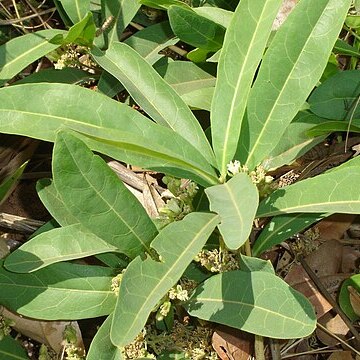Monoecious or dioecious trees, (often scrambling) shrubs, or lianas. Twigs and bark rather tough; medullary rays in twigs many, distinct; pith rather small, usually dark-coloured and often disappearing early; wood rather hard. Stipules narrowly triangular to subulate, sometimes rather early caducous. Leaves spirally arranged but usually pseudo-distichous, short-petioled, pinnatinerved; margin entire, thickened by a nerve; orbicular flat glands nearly always present on the surface of the leaf, mostly beneath in the basal part; base not rarely slightly inequilateral. Growth mode: apparently mostly in flushes. Inflorescences axillary (sometimes pseudo-terminal on leafless axillary shoots), dichotomously branched or glomerulous, sometimes reduced to 2 or 1 flower(s); lower forks with 1 transverse bractlet. Pedicels articulated near the apex. Flowers small, 5-merous, bi-or unisexual, in Mal. spp. hypo-or only slightly epigynous. Sepals ovate, imbricate, slightly confluent at the base, usually pubescent on either side. Petals (in Mal. spp.) free, more or less spathulate, bifid to emarginate, creamy to white when fresh, dark when dried. Stamens 5, episepalous, (in Mal. spp.) free; anthers introrse, opening by a longitudinal slit; connective strongly thickened. Disk consisting of 5 intrastaminal, epipetalous lobes. Pistil 2-or 3-merous, exceptionally 4-merous; styles free or more or less connate; ovules 2 per cell, apical, pendent, anatropous, only one developing into a seed. Drupe usually tomentose, more or less lobed, in Mal. spp. orange or yellow when fresh; pericarp thin, fleshy, the angles usually with distinct sutures apparently indehiscent; endocarp crustaceous; stones 1-3, 1-seeded, often faintly united. The fruits of at least some species are apparently dehiscent (D. papuanum, D. helferianum, D. gelonioides, cf KANJILAL & DAS Fl. Assam 1 1937 246 ), exposing the orange-coloured to scarlet, thin mesocarp. Seeds exalbuminous; cotyledons fleshy, planoconvex.
Small trees, shrubs or lianas. Leaves petiolate. Inflorescences axillary or adnate to petiole, branched cymose or corymbose panicles with long peduncles. Flowers hermaphrodite, polygamous or dioecious, actinomorphic; bracts small; receptacle usually convex or subplanate; sepals 5, imbricate, free, or connate at base; petals 5, free to base, alternate with sepals, usually bicucullate and 2-lobed at apex, margins of lobes inflexed and sometimes enveloping anthers; stamens 5, equal, free, all fertile in male and hermaphrodite flowers, filaments usually free, rarely connate at base only, anthers broadly oblong, introrse; disk usually consisting of 5 hypogynous glands opposite to petals, glands entire, shallowly lobed, free or united; ovary globose, 2-3-locular with 2 ovules in each locule, styles 1-3, free or connate almost to apex, rudimentary pistil present in male flowers. Fruits dry indehiscent drupes, 1-3-locular, usually with 1 seed in each loculus, epicarp pubescent.
Small trees, erect or scandent shrubs. Leaves simple, alternate, spirally arranged, often 2-pseudoseriate, entire; stipules 2, deciduous; petiole short. Flowers small, bisexual or rarely unisexual, in axillary cymes. Pedicel articulated at apex. Sepals 5, imbricate, slightly united at base, differing in size, or equal. Petals 5, free, ± spatulate, apex 2-lobed or subentire. Stamens 5, equal. Glands 5, or disk undulate. Ovary superior, 2-or 3-locular; style free or ± connate. Drupe often pubescent, orange or yellow when fresh; exocarp thin, slightly fleshy; endocarp crustaceous. Seed 1.
Trees or shrubs, erect or scandent. Leaves petiolate, the paired stipules linear or narrowly lanceolate. Inflorescences often laxly cymose-corymbose, few-or usually many-flowered, arising from axils of upper leaves or rarely terminal. Flowers regular, mostly white, short-pedicellate; sepals usually distinct, more or less equal; petals distinct, equal; stamens usually fertile, distinct, more or less equal, the anthers broadly oblong; disk glands 5, opposite the petals or connate into a sinuate disk. Drupe coriaceous with 1, rarely 2, seeds.
Trees, shrubs (often scrambling) or lianes. Leaves alternate, pseudo-distichous, pinnatinerved, usually glandular; glands flat, orbicular, mostly abaxial at base; margins entire, thickened by a nerve; stipules triangular to subulate. Inflorescence axillary, usually dichotomously branched; pedicels articulate near apex. Petals free, bifid to emarginate. Stamens episepalous. Glands intrastaminal epipetalous lobes. Ovary superior. Fruit a drupe, lobed, with or without suture; pericarp fleshy; endocarp crustaceous; stones 1–3, 1-seeded.
Fruits drupaceous, dry or rarely fleshy with (1) 2–3 mericarps; mericarps obtuse or acuminate.
Disk sometimes divided into 5 squamulous glands.
Otherwise characters of the family.
Flowers actinomorphic.
Stamens all fertile.

